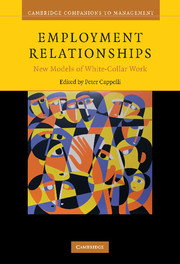Book contents
- Frontmatter
- Contents
- List of figures
- List of tables
- List of contributors
- Foreword
- 1 Introduction
- 2 Corporate restructuring and the employment relationship
- 3 The up and out in organizations
- 4 In the pursuit of quality and quantity: the competing demands in call centers
- 5 Three's a crowd? Understanding triadic employment relationships
- 6 The changed world of large law firms and their lawyers: an opportune context for organizational researchers
- 7 The upside of bureaucracy: unintended benefits for professional careers
- Index
- References
1 - Introduction
Published online by Cambridge University Press: 02 December 2009
- Frontmatter
- Contents
- List of figures
- List of tables
- List of contributors
- Foreword
- 1 Introduction
- 2 Corporate restructuring and the employment relationship
- 3 The up and out in organizations
- 4 In the pursuit of quality and quantity: the competing demands in call centers
- 5 Three's a crowd? Understanding triadic employment relationships
- 6 The changed world of large law firms and their lawyers: an opportune context for organizational researchers
- 7 The upside of bureaucracy: unintended benefits for professional careers
- Index
- References
Summary
The context of new models of white-collar work
The Organization Man, the famous book by Fortune editor William H. Whyte written in 1955 about corporate careers, defined for a generation the career experience of managers entering the business world, as well as the effects of that experience on society. It provided the details for practical issues such as how corporations made hiring decisions (even detailing how to “cheat” on personality tests), how executives thought and acted, and how they got ahead in their careers. In those days, virtually all the good jobs in business were in large corporations.
When The Organization Man was published, and for the generation that followed, business careers began with college recruiting, when employers looked for candidates who could be molded into executives with the values and characteristics appropriate for their company. They looked for potential, and the key component of potential was their personality. Once hired, the company set about training and developing the skills of the young manager – not just their business skills but their social and interpersonal skills. Pressures to conform were considerable, and those pressures extended to their family and to their life outside work. Managers were groomed to see their interests and identity as defined by their organization, hence “the Organization Man.” The defining attribute of careers was that they were governed by the company's rules and interests.
- Type
- Chapter
- Information
- Employment RelationshipsNew Models of White-Collar Work, pp. 1 - 30Publisher: Cambridge University PressPrint publication year: 2008
References
- 7
- Cited by



